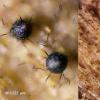
21-12-2025 21:32
Pol DebaenstHello, Garden, Burgweg 19, Veurne, BelgiumOn 10/1

21-12-2025 21:40
Isabelle CharissouBonjour, j'aimerais connaitre les références de

21-12-2025 21:31
Pol DebaenstHello, Garden, Burgweg 19, Veurne, BelgiumOn 10/1

21-12-2025 21:31
Pol DebaenstHello, Garden, Burgweg 19, Veurne, BelgiumOn 10/1

20-12-2025 23:08
Patrice TANCHAUDBonsoir, récolte sur sol sablonneux dans l'arri�

21-12-2025 09:32
Hello.A tiny ascomycete found embedded in wood in

20-12-2025 15:47
Mirek GrycHi.These grew on pine wood that was heavily covere
These very small (up 70 125 microns), superficial, blackish, roundish and pilose ascomata grew on decorticated wood of Quercus ilex. Could be Capronia pilosella/Herpotrichiella moravica with so long hairs up to 210 mic. long? Are these names synonims?
Thanks again
Hopefully this helps,
Regards, Eduard

hairs/setae are not Capronia-like, but typical for Chaetosphaeria species. Are they realy belong to the fruitbodies or are they just surrounding them? I had C. pilosella many times, always with very small spores and distinct black acute setae of ~60-80µm length.
regards,
björn
Hi Björn
Yes. the hairs undoubtedly belong to the ascomata. And yes, my older collections of Capronia pilosella have blackish, short acute setae as you say.
Thanks again



